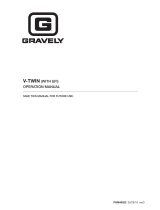
181-1032-14 Four-Cycle Engine • Horizontal Crankshaft • Air-Cooled Page 1
I. General Safety Precautions
!
WARNING
A. Avoid Carbon Monoxide Poisoning
All engine exhaust contains
carbon monoxide, a deadly
gas. Breathing carbon
monoxide can cause
headaches, dizziness,
drowsiness, nausea, confusion
and eventually death.
Carbon monoxide is a colorless, odorless, tasteless gas
which may be present even if you do not see or smell any
engine exhaust. Deadly levels of carbon monoxide can
collect rapidly and you can quickly be overcome and
unable to save yourself. Also, deadly levels of carbon
monoxide can linger for hours or days in enclosed or
poorly-ventilated areas. If you experience any symptoms of
carbon monoxide poisoning, leave the area immediately,
get fresh air, and SEEK MEDICAL TREATMENT.
To prevent serious injury or death from carbon monoxide:
• NEVER run engine indoors. Even if you try to
ventilate engine exhaust with fans or open windows
and doors, carbon monoxide can rapidly reach
dangerous levels.
• NEVER run engine in poorly ventilated or partially
enclosed areas such as barns, garages,
basements, carports, under dwellings, or in pits.
• NEVER run engine outdoors where engine exhaust
can be drawn into a building through openings such
as windows and doors.
B. Avoid Gasoline Fires
Gasoline (fuel) vapors are highly flammable
and can explode. Fuel vapors can spread
and be ignited by a spark or flame many feet
away from engine. To prevent injury or death
from fuel fires, follow these instructions:
• NEVER store engine with fuel in fuel tank inside a
building with potential sources of ignition such as
hot water and space heaters, clothes dryers,
electric motors, etc.
• NEVER remove fuel cap or add fuel when engine is
running.
• NEVER start or operate the engine with the fuel fill
cap removed.
• Allow engine to cool before refueling.
• NEVER fill fuel tank indoors. Fill fuel tank outdoors
in a well-ventilated area.
• DO NOT smoke while refueling tank.
• Use only an approved red GASOLINE container to
store and dispense fuel. Tecumseh recommends
purchasing gasoline in containers with a capacity of
2.5 gallons or less. Small containers are easier to
handle and help eliminate spillage during refueling.
• DO NOT pour fuel from engine or siphon fuel by
mouth. To empty fuel tank see "I. Draining Fuel"
instructions on page 14.
C. Adult Supervision of Operation, Refueling
and Maintenance
The manufacturer of the application may provide
information about who is allowed to use this engine (see
equipment manufacturer’s manual). Not everyone who is
allowed to use this engine is capable of safely and
responsibly operating, maintaining and/or fueling it.
Tecumseh recommends the following:
• An adult should fuel this engine. NEVER allow
children to refuel this engine. See "C. Filling Fuel
Tank" instructions on page 5.
• An adult should perform maintenance on this
engine. See "VII. Maintenance" instructions on page
10. Only allow children to perform maintenance if an
adult has determined they are experienced and
capable of such operation.
• An adult should start the engine. See "G. Avoid
Accidental Starts" instructions on page 2. Only allow
children to start the engine if an adult has
determined they are experienced and capable of
such operation.
To avoid unsupervised operation of the engine, especially
by children, NEVER leave it unattended when it is running.
D. Stay Away from Rotating Parts
NEVER operate the engine with an unguarded engine
shaft. See Figure 1, on page 2.
The equipment manufacturer may
attach a sprocket and chain or pulley
and belt to the engine shaft. If these
parts are not properly guarded, or if you
are not sure whether they are properly
guarded, DO NOT use your engine;
contact the equipment manufacturer.
Hands, feet, hair, jewelry, clothing, etc.
can become entangled in rotating parts,
leading to serious injury or death. To
avoid serious injury or death, be sure the
flywheel guard is in place.
See Figures 1and 2, on page 2.
Read equipment manufacturer’s manual and this
material thoroughly before using this engine. Failure to
do so can result in serious injury or death. Call Tecumseh
Power Company at 1-800-558-5402 or visit
www.TecumsehPower.com if you have any questions.




















